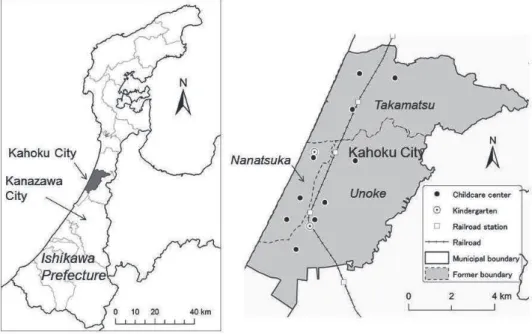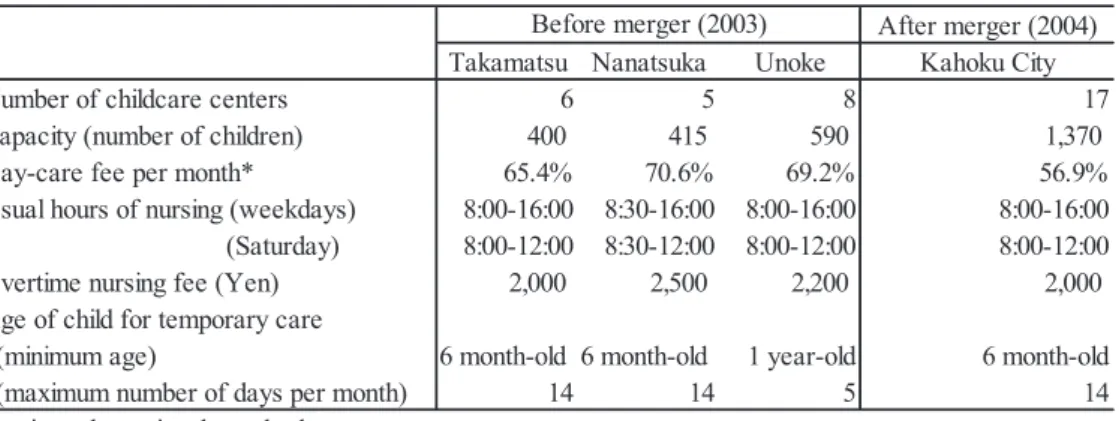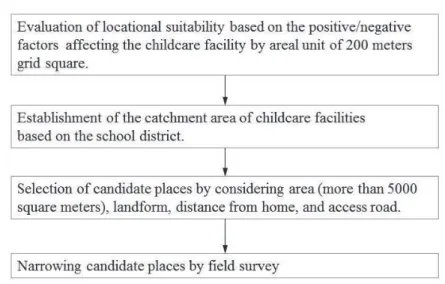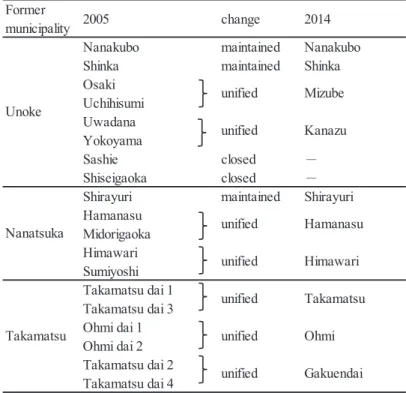GEOGRAPHICAL REPORTS
OF TOKYO METROPOLITAN UNIVERSITY 50 (2015) 89-96
CHANGES IN CHILDCARE SERVICES ACCOMPANYING MUNICIPAL MERGERS: A CASE STUDY OF KAHOKU CITY
IN ISHIKAWA PREFECTURE
Chieko ABE and Yoshiki WAKABAYASHI
Abstract This study examines changes in childcare services accompanying municipal mergers through a case study conducted in Kahoku City, Ishikawa Prefecture. The findings reveal that, in Kahoku City, childcare services improved overall after the merger because factors such as hours of care, fees, after-hours care, and temporary care were adjusted to match the town with the highest standards of the three towns involved in the merger. Behind this improvement was the basic policy adopted by the Council for Merger, which sought to transfer childcare services to the new city without compromising the standard of these services. In Kahoku City, there have been no significant disruptions or problems with childcare services due to the merger; this can be attributed to the fact that merger negotiations proceeded relatively smoothly, and precautions were taken when adjusting aspects of childcare such as care-center management.
Key words: municipal merger, childcare services, childcare support, Kahoku City
1. Introduction
In 1999, the Japanese government amended the Special Mergers Law and sought to reduce the number of municipalities (cities, towns, and villages) in what became known as the “Great Heisei Mergers.” As a result, the number of municipalities decreased from 3,229 in 1999 to 1,718 in 2014.
Previous research has identified the following four objectives of the Great Heisei Mergers: (1) respond to expansions in people’s living area; (2) respond to the arrival of an aging society with fewer children; (3) strengthen the administrative foundations of municipalities as beneficiaries of decentralization; and (4) respond to constrained local government finances (Sasaki 2003). Of these objectives, Morikawa (2013) regards responding to financial austerity as the government’s top priority and argues that the government has forcibly implemented municipal mergers using the
“carrot and stick” technique.
Until now, research has examined various problems related to municipal mergers, including the effect of mergers on public services. Previous geographical research regarding the effect of mergers on public services has primarily focused on welfare services for the elderly. For example, Hatakeyama (2007) examined the effect of geographical barriers on elderly welfare services.
Sugiura (2007, 2009) indicated that uneven relationships between benefits and burdens have emerged as a result of joint administration across municipal boundaries. However, there have been no geographical studies on the effect of mergers on childcare services.
In contrast to elderly welfare services, which are sometimes administered across municipal
boundaries over a wide geographical area, childcare services are generally managed by municipal governments. Thus, it can be argued that services vary significantly among municipalities.
Furthermore, it is conceivable that childcare services would change in the merger process.
Therefore, this study considers changes in childcare services accompanying municipal mergers.
This is a case study of Kahoku City in Ishikawa Prefecture, a provincial city that was established relatively smoothly as part of the Great Heisei Mergers. To examine the process through which childcare services were adjusted and explore the changes that occurred as a result of the merger, an interview survey was conducted in the relevant department of Kahoku City based on the materials produced by the Council for Merger.
2. Overview of the Study Area and the Process of Municipal Merger The geographical features of Kahoku City
Kahoku City was established on March 1, 2004, from the merger of the towns of Takamatsu, Nanatsuka, and Unoke. Located approximately at the center of Ishikawa Prefecture, Kahoku City is a small-scale municipality with a total area of 64.76 km2 and a population of 34,659 as of 2010.
The main industry of the city comprises primary and secondary sectors of industries, such as sand dune agriculture, textiles, electronics, and steel and machinery manufacture. Although some local employment opportunities exist, the number of people commuting to the central city of Kanazawa for work is also relatively high (see Fig. 1).
Fig. 1 Study area and major facilities for childcare support in 2013.
Before the merger, the three neighboring, similarly populated towns already had close reciprocal links. All three towns were facing issues related to aging populations, with more than
16% of residents over the age of 65. Their financial capability indices (Takamatsu: 0.40;
Nanatsuka: 0.42; Unoke: 0.55) revealed that the towns were fiscally weak and relied heavily on government subsidies. Furthermore, the merger was also prompted by anxiety about the future due to the aging population and population decline. Thus, before the merger, Kahoku City faced problems not only common to provincial cities in the Hokuriku Region but also to entire Japan.
Therefore, it is reasonable to assume that the three towns embarked on the merger in an attempt to solve these problems (Table 1).
Table 1 Major indicators of municipalities before merger Takamatsu Nanatsuka Unoke
Area (square kirometer)* 26.4 6.39 31.9
Population* 10,826 11,270 12,574
Number of households* 3,242 3,477 3,843
Rate of aged population (%)* 21.8 18.6 16.5
Financial capability index** 0.4 0.42 0.55
* in 2000, ** three years average for 1997-1999.
Source: Reports of the Council of Merger.
Former municipalities
The merger circumstances
Before the merger, the three towns shared the following problems: declining birthrates and aging populations; declining textile industries; inflexible administration and financial problems;
and increasing public-servise burdens. Therefore, with the aim of restructuring and restoring administrative functions and finances, the “Council for the Merger of Takamatsu, Nanatsuka, and Unoke” was established in April 2002, and Kahoku City was born on March 1, 2004. Thus, Kahoku City was formed approximately two years after the establishment of the Council for Merger, which is the first merger among the Great Heisei Merger cases in Ishikawa Prefecture.
During the preparations for the merger, a meeting was held for local residents to establish consensus among them in accordance with the Special Mergers Law and explain them what was happening. In Takamatsu and Nanatsuka, questionnaires about the merger were distributed among the residents in November and December 2001, the results of which revealed that more than 70%
of residents approved of the merger.
As part of its basic policy, the Council for Merger sought to uphold fairness and harmony among the three towns. Furthermore, the Council pursued a basic policy of adjusting services to the standards of “the town with the lowest burden” regarding public-service charges and to “the town with the highest standard of services” for childcare and other services provided by the city. It is reasonable to assume that this policy was influenced by the fact that the towns were similar in size, and the merger was implemented equitably across the three towns.
The child-rearing environment in Kahoku City
Matsuda (2013) identified high female employment rate as a characteristic of the Hokuriku Region from the perspective of child-rearing: in 2010, the rate of female employment in Ishikawa Prefecture was 52.2%, the second highest in Japan. Furthermore, Ishikawa’s total fertility rate of 1.56 surpasses the national average of 1.39. Kahoku City’s child-rearing environment is typical for
the Hokuriku Region.Waiting lists for licensed childcare centers have, for a long time, remained at zero. According to the 2010 national census, the proportion of young people was high at 24.1%, and, in addition to the high fertility rate, figures suggested that the area was experiencing a large influx of families with children. An examination of household composition revealed a characteristically high proportion of three-generation households (18.8%). When close relationships among residents (grandparents living nearby) are also taken into consideration, the characteristics of the area make it easy for parents to receive child-rearing support from relatives.
As of 2014, Kahoku City’s child-rearing and childcare facilities comprised ten licensed childcare centers, two kindergartens, and five children’s centers (see Fig. 1). Childcare centers are situated so that the premerger balance among the three towns is maintained, with three centers each in Takamatsu and Nanatsuka and four in Unoke.
3. Changes in Childcare Services as a Result of the Merger
Table 2 contains details about childcare services provided before and after the municipal merger. Although similar services existed in all three towns, the attributes of these services—for example, the children eligible for the services, cost, and subsidy amounts—varied from municipality to municipality. These differences reflected each municipality’s approach to child welfare, which in turn reflected differences in budget allocations as determined by the municipalities’ financial resources. With reference to Table 2, let us examine the major changes in childcare services that resulted from the merger.
Table 2 Childcare services bofore and after merger
After merger (2004) Takamatsu Nanatsuka Unoke Kahoku City
Number of childcare centers 6 5 8 17
Capacity (number of children) 400 415 590 1,370
Day-care fee per month* 65.4% 70.6% 69.2% 56.9%
Usual hours of nursing (weekdays) 8:00-16:00 8:30-16:00 8:00-16:00 8:00-16:00 (Saturday) 8:00-12:00 8:30-12:00 8:00-12:00 8:00-12:00
Overtime nursing fee (Yen) 2,000 2,500 2,200 2,000
Age of child for temporary care
(minimum age) 6 month-old 6 month-old 1 year-old 6 month-old
(maximum number of days per month) 14 14 5 14
* ratio to the national standard
Source: Reports of the Council of Merger.
Before merger (2003)
The operating hours of childcare facilities in Takamatsu and Unoke were the same; however, services in Nanatsuka began 30 minutes later. After the merger, services in Nanatsuka improved because the hours of care were adjusted to match the higher standards of Takamatsu and Unoke.
Kahoku City offers an after-hours care service enabling parents to extend the duration of care beyond regular hours. Before the merger, the monthly cost of after-hours care varied among the three towns. After the merger, services in Nanatsuka and Unoke improved since monthly fees
were adjusted to match the town with lowest fees, Takamatsu.
Before the merger, the cost of childcare significantly varied among the three towns. The fees were 65.4%, 70.6%, and 69.2% in Takamatsu, Nanatsuka, and Unoke, respectively, with respect to the national standard. In particular, Nanatsuka, the town with the highest fees, has seen a significant reduction of costs (to 56.9%) after the merger. Therefore, in terms of cost, services improved in all three towns.
Temporary care is a system in which childcare services are provided on a temporary basis when necessary—for example, when parents are ill, busy caring for elderly family members, attending ceremonies such as weddings and funerals, or taking a needed break from childcare. In Takamatsu and Nanatsuka, temporary-care services were available for children “from six months old”; however, in Unoke, the minimum age was “one year.” The number of days on which temporary childcare could be used were “up to 14 days per month” in Takamatsu and Nanatsuka;
however, the number of days was lower in Unoke, which offered a similar service for “up to 5 days per month.” After the merger, services in Unoke improved as the eligible age came down to
“from six months” and the number of days was increased to “up to 14 days” because services were adjusted to match the higher standards of the other two towns.
4. Consolidation of Childcare Centers
The fill rate of childcare centers in Kahoku City had been decreasing since before the merger, falling below the student quota to 83.3% in 2004. Although it was expected that the number of preschool children would continue to decrease even after 2004, it was necessary to increase the number of childcare workers because the number of children below the age of one being enrolled in childcare centers was increasing, and the need for childcare on Saturdays and holidays was growing, along with after-hours care. At the time, fill rates varied significantly among the 17 childcare centers in the city, and many of the center’s buildings constructed before the 1970s were in a decrepit state; therefore, childcare centers were consolidated to improve the efficiency of their operations.
In 2005, before the consolidation of the centers, Kahoku City administered a questionnaire survey to 860 parents and guardians (response rate: 90.2%). The City examined parents’ requests concerning the location and services of childcare centers on the basis of the questionnaire responses and determined the important issues and improvement policies to address them. The questionnaire primarily focused on residents’ wishes to consolidate childcare centers and other matters they considered to be important with regard to childcare facility location.
The most common wish regarding the consolidation of childcare centers was for improvements in physical facilities and playing equipment. Second, parents requested improvements in the quality of services and capacity of child care givers. Third, parents hoped to see improvements in food and various experiential activities offered by childcare centers.
The most common wish regarding the location was for childcare centers to be located where children could take walks and experience nature, such as areas close to parks and other green areas.
Second, parents requested locations without noise pollution, vibrations, and offensive odors. Third, parents hoped that childcare facilities would not be located on busy or narrow roads. A post-merger improvement policy was determined on the basis of these results.
Fig. 2 The process of consolidation of childcare facilities in Kahoku City.
Source: A Plan for Allocating Childcare Facilities in Kahoku City (2006).
Specifically, the planning process behind the consolidation described in the “Kahoku City Childcare Facilities Improvement Plan” defined a policy about consolidation on the basis of residents’ opinion surveys and calculated the required number of childcare centers, considering demand forecasts and the commuting range. The number of children attending childcare centers in the future was projected by adding the developed population to the projected population using the cohort change rate method. The estimate for the required number of childcare centers in the future was derived by supposing a quota of 125 children per center and considering the percentage of children attending childcare centers (57%) and the fill rate (84.1%). As a result, Kahoku City decided to provide a total of 10 childcare ceneters: three each in Takamatsu and Nanatsuka and four in Unoke. Figure 2 shows the process through which the consolidation plan was carried out.
Table 3 summarizes the post-merger changes in licensed childcare centers for each of the three former towns. In Unoke district, the number of centers decreased from six in 2004 to four in 2013.
In Takamatsu district, the number of centers halved from six in 2004 to three in 2013. In Nanatsuka district, the number of centers decreased from five in 2004 to three in 2013. The total number of centers decreased by seven, from 17 in 2004 to 10 in 2013.
Although the aim of the consolidation was to reduce childcare center expenses, as demonstrated by Figure 3, which shows the change in the number of childcare centers in Kahoku City and the change in childcare centers’ general-management expenses, targets were not always achieved. As mentioned above, the number of childcare centers decreased between 2004 and 2012; however, this does not mean that childcare centers’ general-management costs decreased across the board. Therefore, it is reasonable to assume that Kahoku City must further reduce fixed costs, such as personnel costs, to control childcare expenditures.
Table 3 Consolidation of childcare centers in Kahoku City after merger Former
municipality 2005 change 2014
Nanakubo maintained Nanakubo
Shinka maintained Shinka
Osaki Uchihisumi Uwadana Yokoyama
Sashie closed -
Shiseigaoka closed -
Shirayuri maintained Shirayuri Hamanasu
Midorigaoka Himawari Sumiyoshi Takamatsu dai 1 Takamatsu dai 3 Ohmi dai 1 Ohmi dai 2 Takamatsu dai 2 Takamatsu dai 4
Source: Information provided by Kahoku City Unoke
Nanatsuka
Mizube Kanazu
Takamatsu Hamanasu unified
unified
unified unified unified unified unified
Himawari
Takamatsu Ohmi
Gakuendai
Fig. 3 Change in the number of childcare centers and their expenses in Kahoku City.
Source: Information provided by Kahoku City.
5. Conclusion
This study examined changes in childcare services accompanying municipal merger through a case study conducted in Kahoku City, Ishikawa Prefecture. The findings reveal that, in Kahoku
City, childcare services improved overall after the merger because aspects such as hours of care, fees, after-hours care, and temporary care were adjusted to match the standards of the town with the highest standards of the three towns involved in the merger. Behind this improvement was the basic policy adopted by the Council for Merger, which sought to transfer childcare services to the new city without compromising quality. Furthermore, since the merger in Kahoku City, the number of children awaiting a place at an approved childcare center has remained at zero, and there have been no significant disruptions or problems related to childcare services as a result of the merger. Arguably, success can be attributed to the fact that the merger was implemented relatively smoothly, and the consolidation of childcare centers and adjustment of services were handled judiciously.
However, it is still unclear whether the standard of services can be maintained in the future, after special financial provisions are reduced ten years after the merger. It is possible that consolidation, privatization, and private outsourcing will increase in the future as a means of reducing the financial burden of childcare services. Compared with the metropolitan area, the supply of childcare services seems to be sufficient, and the childcare environment favorable;
nevertheless, continued measures that consider the characteristics of the local area are needed to maintain these conditions.
Acknowledgements
This paper is dedicated to Professor Yoshio Sugiura on his retirement from Tokyo Metropolitan University. We thank staff members of Kahoku City Office for providing us useful information on childcare services and the process of merger.
References
Hatakeyama, T. 2007. Effects on elderly welfare services of the merger of municipalities with geographic barriers: Case study in Numata, Gunma Prefecture. Geographical Review of Japan 80(13): 857-871.**
Mastuda, S. 2013. Shochika-ron (Declining birthrate theory). Tokyo: Keiso Shobo.*
Morikawa, H. 2013. Current state and problems of Heisei municipal pro-merger policy.
Jichi-Soken 421: 68-83.*
Sasaki, N. 2003. Shichoson Gappei (Municipal merger). Tokyo: Chikuma Shobo.*
Sugiura, S. 2007. Joint administrations and extended insurers of the long-term care insurance system. Japan Association of Economic Geographers 53:237-264.**
Sugiura, S. 2009. Differences in characteristics of long-term care insurance services among municipalities under recent municipal mergers in Japan. Geographical Review of Japan Series A 82(3): 188-211.**
(*: in Japanese, **: in Japanese with English abstract)




